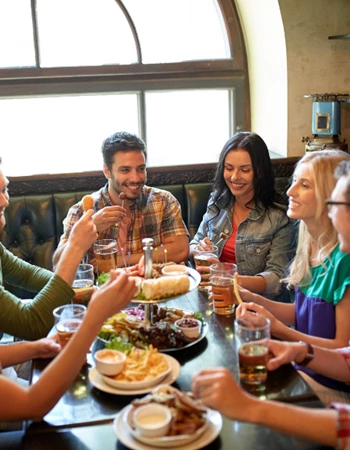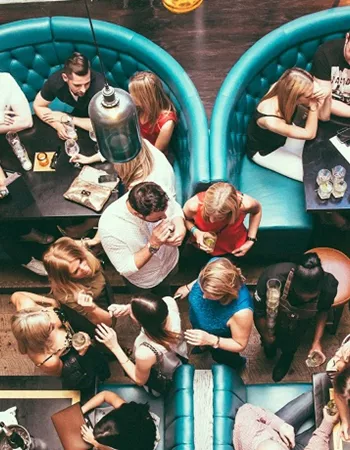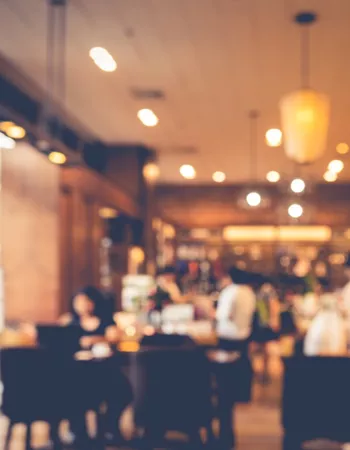-
- Solutions by business priority
- Boost efficiency and profitability
- End to end workforce management
- Attract customers and increase bookings

How to set up a customer loyalty programme for restaurants
Customer loyalty programmes are a valuable tool that can help increase customer loyalty, increase average spend, improve brand attitude and provide you with a goldmine of customer data. According to a 2018 YouGov survey, 72% of UK consumers think they are a good way to reward customers and 77% are members of at least one such scheme.
If you are considering adding a customer loyalty programme to your marketing plan for your hospitality business, then you are probably wondering which one is right for you.
Here at Access Hospitality, we help thousands of businesses set up effective programmes to enhance customer loyalty by rewarding interaction and deepening your customer relationships. And loyalty schemes aren’t just for big chains – we’ve helped operations of all sizes get their customer loyalty programmes off the ground.
 10 mins
10 mins

Written by Jo Fontaine
Information on this page
- What is a restaurant customer loyalty programme?
- Are restaurant loyalty programmes effective?
- Examples of restaurant customer loyalty programmes
- Best restaurant customer loyalty programmes
- 7 steps to setting up a restaurant customer loyalty programme
- Why customer loyalty is more than a rewards programme
- What are the disadvantages of reward programmes for restaurants?
What is a restaurant customer loyalty programme?
A restaurant customer loyalty programme is a marketing strategy used by restaurants and hospitality businesses to incentivise repeat business from their customers. The programme typically rewards customers for making purchases at the restaurant by giving them points or other rewards that can be redeemed for discounts, free menu items, exclusive offers or other perks.
The wider goals of a restaurant customer loyalty programme are to increase customer engagement, build brand loyalty and drive repeat business. An added benefit of some customer loyalty programmes is the ability it gives businesses to collect data about customer behaviour and preferences, which can be used by the restaurant to improve its overall customer experience and marketing efforts.
Put simply, a restaurant customer loyalty programme is a way for you to reward customers who visit your restaurant frequently. It's a great way to show your appreciation, and it can help you keep your regulars coming back again and again.
Are restaurant loyalty programmes effective?
Customer loyalty programmes harness some basic facets of human psychology to keep customers returning again and again to your restaurant. If you’ve ever given a child a gold star sticker for good behaviour or earned a bonus for smashing a sales target then you’ve experienced positive reinforcement, an exceptionally powerful motivator.
Positive reinforcement is just the technical term for deliberately associating good feelings with certain behaviours to encourage us to repeat those behaviours. This is the basis of forming good habits. A customer loyalty programme is one way you can impact on your customer’s behaviour and get them in the habit of visiting your restaurant. When your business offers customers little treats that make them feel good about their decision to interact with you, they are more likely to visit again.
It sounds very simple, but to really maximise this positive urge you will need to dig a little deeper into your customer’s needs.
Our tips for making sure customer loyalty programmes are effective:
Keep it simple
A programme that involves a fiddly procedure every time your customer exhibits the behaviour you want them to will discourage participation in the programme. Good loyalty programme design will make registering the behaviour and distributing the reward feel as seamless and instant as possible.
Exclusivity
Feeling like you have gained something not accessible to everyone else increases the perceived value of the reward exponentially. If you aren’t going to include every customer in your programme, then it’s important to target the customers who are likely to respond well to your programme by understanding their purchasing behaviour. You could also introduce a feeling of personalisation by adding extra points or vouchers on someone’s birthday or the anniversary of them joining the programme, a date that will feel special to them.
Little and often
Large rewards in the distant future do not have the same motivational power as small rewards in the here and now. Choosing the size of your reward is incredibly important. If the rewards you are providing are too small then it will not be effective, but if they are too big then the cost of supplying them will start to eat into the profits from the extra custom.
Full visibility
Visibility to the customer of the points they have accumulated or the rewards they are due is an incentive to engage; after you want them to cash in on these rewards and become loyal customers. Visibility is easier to maintain with online systems such as an app.
Consistency
Enthusiasm for a rewards programme may be high in the beginning but can easily be forgotten about. Getting the programme back to top of mind could be as simple as setting up automated reminder emails on a regular basis. See our guide on Everything you need to know about restaurant marketing automation for more insights about how to incorporate automation into your marketing efforts.
Thinking through the behavioural insights that underpin customer loyalty programmes makes it clear that data collection is an important facet of turbo-charging your loyalty scheme. A restaurant loyalty programme allows restaurants to gain insights into their customers' preferences through data collection and analysis of their behaviour. A powerful CRM, like our own hospitality CRM, Acteol, will be able to collect data from a customer’s loyalty account and use it in a variety of ways to underscore marketing decisions and make the loyalty programme as effective and as enticing as possible.
Examples of restaurant customer loyalty programmes
Unit programmes
A unit programme refers to the classic stamp card collection system usually associated with coffee shops.
A customer receives a stamp (or digital equivalent) for each unit sold and receives the nth unit free. Its simplicity and ability to deliver small rewards frequently for not much cost make this popular with customers and owners alike.
A downside is that actual physical stamp cards are low on visibility (often forgotten at the time of purchase) and do not offer any means of collecting customer insights, so most restaurants now prefer to use a digital version if they decide to implement this kind of programme.
- The simplest programme to execute
- Can be lower cost than other programmes
- Less opportunity for data collection if using a physical card
Points-based programmes
One of the most common customer loyalty schemes is a points programme. A points programme lets customers accumulate reward points they can redeem for freebies, discounts, cash back or other perks. They could also earn points for other valuable activities, such as filling out surveys, sharing on social or leaving reviews.
Unlike a unit programme, a points programme requires a database that can track a member’s purchases and points. Data can then be collected from this system, so it is well worth investing the time and effort in getting the back end just right.
- Highly brandable by giving the wallets or points an on-brand name
- Fertile ground for data collection
- Needs to integrate with other software
- Can get too complicated if too many features are added at once
Tiered programmes
Remember that earlier we said that customers like to feel special? Well, you can leverage that innate human desire by designing a tiered loyalty programme.
Customer rewards programmes that reward various segments of consumers differently are known as tiered loyalty programmes as they typically take the shape of a hierarchy, with each tier providing progressively more rewards, often in the form of exclusive deals and discounts. This way you can reward your best customers and encourage them to spend more with your business.
A tiered programme requires the most initial analysis of your customer base but also may pay off the most in terms of data collection.
- Great if you have a high-spend regular customer base
- Can create a sense of community between tier members
- Can feel exclusionary
- Customers may end up in non-optimal tiers and miss offers they would take up
Values programmes
Most rewards take the form of points to be parlayed into money off, vouchers or free goods.
A more recent innovation is allowing a customer to donate points to a charity that has partnered with your restaurant, or a “pay it forward” approach to enable your restaurant to do good works in the community. This is a different take on making the customer “feel good” to the traditional loyalty programme but could really align with your brand values and help build a sense of community.
- A values programme can help you stand out from competitors
- Builds a sense of community
- Partnering with a charity is an opportunity to build a caring and trustworthy brand
Best restaurant customer loyalty programmes
Zizzi - Zillionaires Club
Zizzi's Zillionaires Club loyalty programme offers customers a digital platform where they can earn Zs, which are points that can be exchanged for food rewards, known as Perkz. This loyalty scheme is designed to incentivise frequent visits and provide personalised experiences that cater to customers' dietary preferences.
When customers sign up for the Zillionaires Club, they are immediately rewarded with a free garlic bread. From there, they can earn points by making purchases in-venue, using delivery or click and collect services. Additionally, every fourth visit, customers receive an extra perk to encourage them to keep returning.
During the sign-up process, the Zillionaires Club collects personalised information, such as dietary preferences and allergens, so that it can offer tailored experiences to its members. Members can also take advantage of seasonal offers that are promoted through the platform, such as 30 bonus Zs for every visit in February, with a "book your table" prompt.
One unique feature of the Zillionaires Club is the ability to donate points to a charity. This feature not only provides a way for customers to give back, but it also adds a charitable element to the loyalty program.
At a glance, the Zizzi Zillionaires Club loyalty program features:
- Incentive to join with a free garlic bread reward
- Points can be earned through in-venue, delivery, and click and collect purchases
- Personalised information collected during sign-up, including dietary preferences and allergens
- Seasonal offers available with a "book your table" prompt
- Extra perk rewarded every fourth visit to encourage frequent visits
- Ability to donate points to a charity
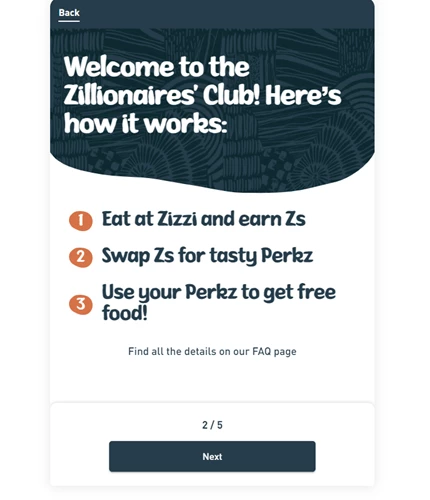
Itsu – Butterflies
The Itsu Butterflies loyalty program is a fantastic example of how a simple yet effective approach can create a winning customer loyalty scheme. This loyalty program is based on the Itsu logo, with butterflies that represent grace and beauty, which is the essence of Itsu's products.
The Itsu Butterflies program is designed to be user-friendly and convenient for customers. To participate, customers need to download the app and start collecting butterfly stamps every time they spend £5 or more at Itsu. Once they have collected seven butterflies, they are rewarded with a complimentary “Eat Beautiful” dish, snack, or drink.
The program is entirely digital, which makes it easy for customers to use, and they can also benefit from click and collect services. The app also features a venue locator, so customers can quickly find the nearest Itsu store. The loyalty scheme is simple to understand and follow, with no complicated rules or restrictions.
To make the program even more rewarding, Itsu offers a bonus butterfly stamp for every customer who invites a friend to join the program. This not only encourages customer loyalty, but it also helps spread the word about Itsu's delicious food offerings.
At a glance, the Itsu Butterflies loyalty program features:
- Digital stamp card loyalty scheme
- Easily achievable butterfly stamps
- App-based with click and collect services
- Venue locator for easy access
- Simple and easy to follow
- Bonus butterfly stamp for inviting friends to join
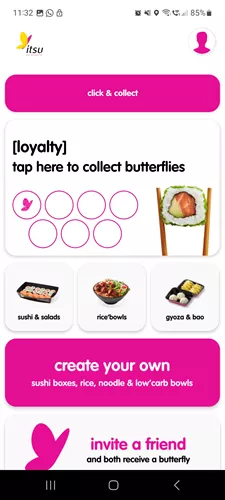
Peach Pubs - Peach Club
The Peach Club loyalty program, offered by Peach Pubs, is a great example of a digital platform that connects multiple touchpoints and functions to create a comprehensive customer experience. The app offers more than just rewards - customers can use it to order and pay from their table, leave reviews, buy gift vouchers, and even find a job.
The Peach Club loyalty program offers customers an achievable incentive of a free coffee after collecting 10 stamps on the coffee stamp card feature. Additionally, customers can earn on-brand "Peachy Perks" every fifth visit to the pub, and they can also load "Peach Pounds" onto their digital card to use against future bills. The app's push notification prompt ensures high visibility on the users' phone.
The bill management feature, which includes the ability to split bills, open a tab, and leave visit feedback, gives customers a lot of control and incentivises them to keep the app for all the functions and convenience as well as associating reward with spend. The "Find a Venue" feature helps customers locate a Peach Pub more easily as each pub has its own individual name.
The app also offers web links to blogs and news that will be of interest to customers, which drives brand values. Special offers within the group, such as overnight stays, can be advertised through the app, and customers can even buy gift vouchers. Lastly, the app includes links to recruitment for those interested in working for Peach Pubs.
At a glance, the Peach Club loyalty program features:
- Achievable incentive of a free coffee after collecting 10 stamps on the coffee stamp card feature
- On-brand "Peachy Perks" earned every fifth visit to the pub
- Ability to load "peach pounds" onto digital card for future use
- Push notification prompt ensures high visibility on users' phone
- Bill management feature includes split bills, open tab, and leave visit feedback
- "Find a Venue" feature helps customers locate a pub within the stable
- Web links to blogs and news that will be of interest to customers
- Special offers advertised through the app, such as overnight stays
- Option to purchase gift vouchers
- Links to recruitment for those interested in working for Peach Pubs
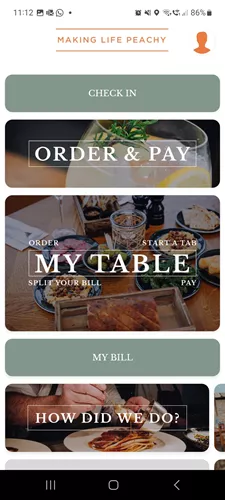
7 steps to setting up a restaurant loyalty programme
The effectiveness of a restaurant loyalty programme also depends on how well it is marketed and executed, so it’s important to choose a programme that aligns with your business goals and values.
Here are eight steps to consider when setting up your restaurant loyalty programme.
Step 1: Define your objectives
What do you want to achieve with your loyalty programme? Do you want to encourage customers to visit more frequently, increase average order values or promote a particular menu item? Setting out clear objectives will help you measure the success of your programme later down the line.
Step 2: Choose a loyalty programme type
Decide on the best loyalty solution for your business based on your budget, resources and goals. Consider the features and benefits of each option and choose the one that works for your business.
Step 3: Choose your tech
Decide on a platform and how your customers will sign up or participate, such as signing-up in-store or online, through a mobile app, or via a third-party system. How will you manage your loyalty programme after you get started and measure success?
Step 4: Select rewards
Choose your loyalty programme rewards carefully. It can be good to keep things simple and offer a free coffee for every 10 coffee stamps – but this may well exclude a huge portion of your customer base – and may not work well for pubs, bars and restaurants. A points based system can offer more general appeal with customer selected options for redeeming points against items they like.
Step 5: Integration
Integrate your restaurant loyalty programme with your CRM so you can collect customer data to inform future marketing activities and deliver more personalised communications.
Step 6: Promote
Develop a marketing plan to promote the loyalty programme to customers and encourage sign-ups through in-venue signage, social media, email and other marketing channels.
Step 7: Monitor results
Continuously evaluate and refine the programme to ensure it is meeting the goals you have set for it, and it is providing value to both customers and the business.
Customer loyalty is more than a rewards programme
While an effective rewards programme will enhance customer loyalty for your company greatly, there are still other factors to consider when thinking about the overall concept. Customer loyalty is perhaps best thought of as a measure of the strength of the relationship between a customer and a brand and is based on factors such as satisfaction with the brand, trust in the brand and perceived value.
Customer loyalty can be influenced by various factors such as quality of products or services, price, customer service and the overall customer experience and all of these need to be carefully monitored through data insights from an effective hospitality CRM.
What are the disadvantages of reward programmes for restaurants?
While loyalty programmes can be beneficial for restaurants, bars, pubs and other hospitality businesses, there are some potential disadvantages you should consider before you get started:
1. Cost
Loyalty programmes can be expensive to set up and maintain, especially if your business offers substantial rewards. Smaller operators might find that a simple unit programme is easier to maintain than a complex app or website.
2. Cannibalisation
Loyalty programmes are great to encourage more frequent visits, but regular rewards may shift customers spending away from the higher-margin items and opt for the ‘cheap’ reward instead.
3. Complexity
A good reward programme should be easy for your customers to understand and your teams to explain. Multi-layered offers or partial rewards and money off selected items can get a little complicated and lead to frustration if your customer misunderstands the value of their reward.
4. Customer expectations
Your customers might come to expect rewards or discounts as a regular part of their experience, and this could devalue your offering (think quick service chains who people won’t order from without a voucher code!) and even lead to lost business if you decide to cut back on your reward offering.
5. Fraud
Reward programmes can be susceptible to misuse and fraud with people attempting to ‘hack’ your scheme, claim rewards they haven’t earned or share what should be exclusive voucher codes. This can be difficult to control, and you may have to accept a certain level of misuse.
6. Loyalty overload
There are so many loyalty schemes available that customers might feel disinclined to add yet another business app on their phone or follow a longer-term scheme, i.e., if it takes a year to get enough points to earn a reward, the customer may well have forgotten all about signing up. Keeping rewards little and often alongside a long-term goal can help as well as regular marketing about your scheme – but keep it relevant to your customer.
Kick off your customer loyalty programme in your restaurant or hospitality business
In this article we’ve explored the concepts that underpin customer loyalty, including behavioural insights into what consumers want from a reward programme. As well as looking at the different types of loyalty programmes available and their respective benefits.
Our hospitality CRM, Access Acteol, enables you to build on brand loyalty by gathering insights into your customers’ needs and preferences. By interfacing with other marketing activities, such as automated email campaigns, vouchers, customer analysis and personalisation, you can create a restaurant loyalty programme that will improve customer loyalty and increase returning customer visits.
Find out more about our loyalty and rewards solution, as part of our CRM
Find out more about our hospitality CRM, Acteol, and how it can help you increase customer loyalty in your restaurant
More about customer loyalty
Related resources to support you
